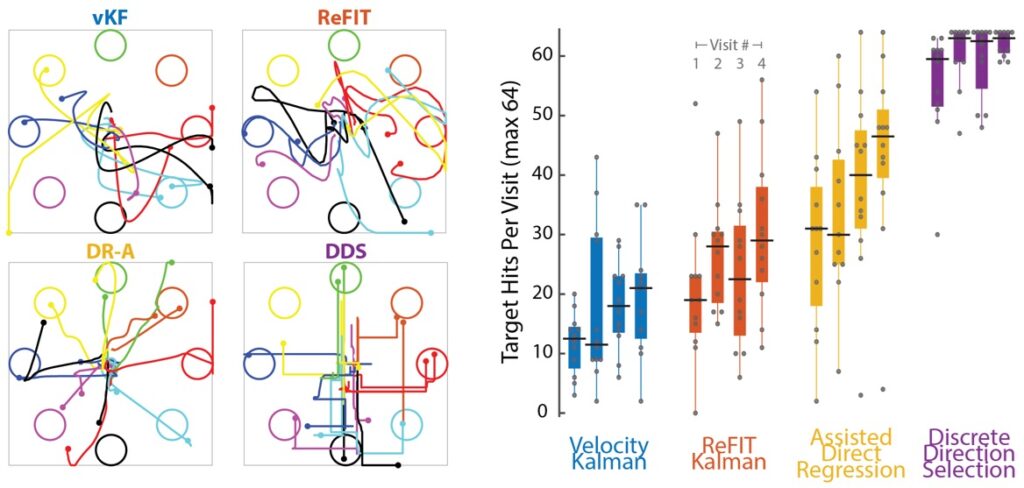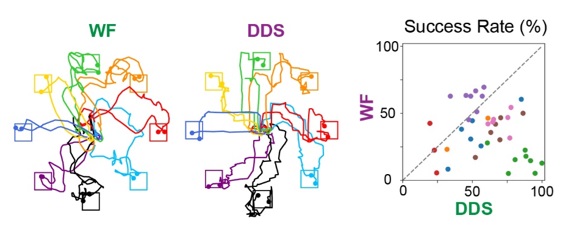Intracortical brain-computer interfaces (iBCI) read in neuron activity and use it generate useful actions, potentially giving paralyzed users control of a device. A common goal is to establish brain control of a computer cursor, since that effectively unlocks most digital technology. This post is about our new twist on the way that control is set up; instead of giving users carte blanche cursor movement we strictly limit what it is allowed to do, and for some reason that seems to help (a lot).
Computer mouse-controlled cursors can move at any speed in any direction at any time to reach wherever on the screen people want to go, so it seems natural that brain-controlled cursors should work the same way. This has been the approach for many years; we would translate neuron activity into cursor velocity with a modified navigation filter or with artificial neural net magic. It let users move the cursor however they want, just like with a computer mouse. It works well, but its not as accurate as we would want to convince people it is worth getting brain implants for, and certainly not well enough for people to stop writing scientific papers about how to make it better.
But it turns out that if you don’t let the cursor move at all, i.e. you force users to select from a list (of computer icons or letters), they are way more accurate. At some level, maybe it isn’t surprising that list-selection is easier than continuously controlling the cursor. After all, continuous velocity control requires you to be accurate all the way to the goal whereas directly choosing the goal skips over all the intervening onscreen territory. Reducing the user accuracy burden is important because users of these systems tell us that iBCI operation is more like learning the controls for a complicated computer game than sitting back and having your mind read. But the cost of list selection is relinquishing full access to the onscreen area. List selection is limiting when you cannot build in advance an exhaustive list of possible selections one would need, or when software screen layouts are dynamic, or when we want to control a setting that is fundamentally continuous.
Our solution is the Discrete Direction Selection (DDS) decoder. DDS keeps the efficiency of choosing off a short list, but each selection is a direction rather than a target. In this way users can very accurately select which among four directions they want to move in (or stop) and still retain the ability to get anywhere onscreen. Intuitively, one might suppose that this would be a disaster since it requires L-shaped paths to get places rather than the straight lines continuous velocity decoders can (theoretically) generate. But it didn’t turn out that way. The L-shaped trajectories and lower cursor maneuverability were a small price to pay for the improved selection accuracy.
We had 48 healthy participants use an iBCI model (the jaBCI) and try a relatively difficult task of moving to and staying in small onscreen targets; people using DDS got more hits than 3 common continuous velocity iBCI decoders (velocity Kalman, ReFIT, and direct linear regression). Most DDS users were quite literally “off the chart”, since they could have hit even more targets but we only gave them the chance to hit 64.

Its great to see these promising results across so many people and decoders, but the nagging thought is always that a model like the jaBCI is missing a crucial feature of the real world that would prevent DDS from working well in an iBCI. Our Northwestern collaborators came to the rescue and implemented DDS in an iBCI controlled by a monkey. They found the same big performance gap between DDS and a direct linear regression decoder (the Wiener filter, WF) when they flip-flopped which decoder the monkey used throughout a session: 61% of targets hit with DDS and 37% with WF.

It looks like the DDS concept of selecting directions, rather than locations, off a list is a great compromise between maneuverability and ease of use for cursor target tasks, and is an extremely exciting result that opens the possibility of a whole family of algorithms that share this philosophy. We can’t say definitively why limiting user command options with DDS was so effective, but spatial denoising of high frequency errors, co-adaptation, or easier classification of lists vs continuums are all possibilities that we will investigate next. Whatever the reason, hopefully DDS-type decoders will provide robust and efficient control in upcoming iBCIs.
Alcolea P, Ma X, Bodkin K, Miller LE, Danziger ZC, “Less is more: selection from a small set of options improves BCI velocity control.” J. Neural Engineering DOI 10.1088/1741-2552/adbcd9
Get the data on Dryad: https://doi.org/10.5061/dryad.wh70rxwx6
